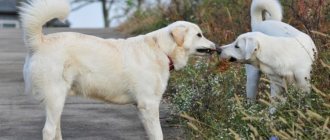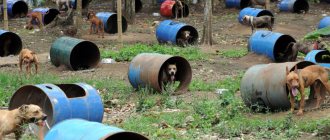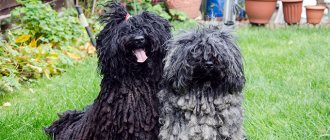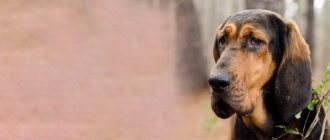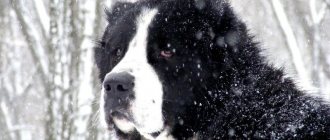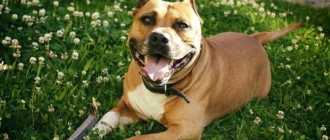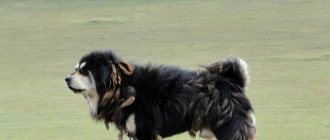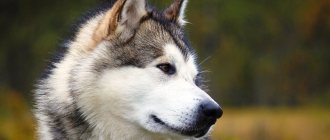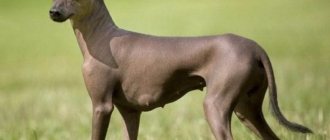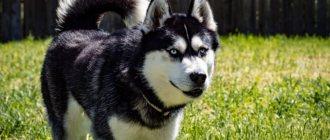Akbash
- Origin: Turkey
- Height: from 69 to 86 cm
- Weight: from 41 to 64 kg
- Life expectancy: 10 to 11 years
- Temperament: intelligent, loyal, independent, fearless
The Akbash is an ancient breed that originated in the plains and mountains of western Turkey, where it was bred by villagers and shepherds to protect livestock from wolves and other predators. Although the Akbash is the Turkish counterpart to other white guard dog breeds found in the northern Mediterranean basin, it is the only breed that has a distinct combination of mastiff and hound characteristics .
Like other hounds, the Akbash is distinguished by long limbs, a deep chest and a tucked belly. The influence of the Mastiff breed is evident in height, weight, broad head and powerful body. The wedge-shaped head is adorned with floppy ears, and the long tail curls behind the back when moving or excited.
This white, lean, muscular dog has a wary gaze and a regal appearance that conveys all its power, strength and courage. Akbash also has the speed and agility it needs to fight and chase predators.
Akbash can be both a domestic companion and a guard dog. He is calm, quiet, independent and balanced. Akbash is loyal, affectionate and attached to his human family, children and other pets. He is naturally wary and suspicious of strangers and can be territorial towards other dogs. This dog takes well to training and must be properly socialized from an early age to become a good family dog.
This white dog breed's medium to long coat, which may have a slight biscuit or gray tint around the ears or undercoat, should be brushed weekly to remove dirt and loose hair. Periodic bathing, regular teeth brushing and nail trimming are also among the breed's basic grooming needs. Although the Akbash's activity level is relatively low, this pet is best suited to homes with a large fenced yard that provides it with plenty of room to run around.
Health and illness, life expectancy
By nature, the wolfhound has excellent immunity. He is not afraid of weather changes, he knows how to resist viral diseases. This is what distinguishes native breeds. It is genetically determined that the wolfhound feels excellent. Otherwise, it would not have survived in nature.
Traditionally, due to the size and build, the dog has a tendency to develop the following problems:
- obesity caused by good appetite, poor nutrition, which leads to diabetes;
- eye diseases (cataracts, conjunctivitis, ectropion);
- volvulus of the stomach, characteristic of large dogs with a developed sternum, when too much food, water, intense exercise leads to volvulus;
- congenital heart failure;
- dysplasia of the elbow, hip, hock joints.
All dogs, including wolfhounds, are susceptible to infectious diseases: distemper, enteritis, piroplasmosis, ringworm. Prevention requires vaccinations that will create immunity and reduce the risk of disease.
It is necessary to carry out deworming and antiparasitic treatment.
Wolfhounds live on average 8-10 years. With good care, long-livers occur. It all depends on the conditions of detention, nutrition and genetic predisposition. The larger the breed, the shorter its lifespan.
Anatolian Shepherd (Kangal)
- Origin: Turkey
- Height: from 63 to 80 cm
- Weight: from 40 to 60 kg
- Life expectancy: 11 to 13 years
- Temperament: sensitive, independent, alert, protective, calm
The Kangal is a large, powerful, strong dog with great endurance and agility. This breed's coat consists of a thick undercoat and an outer coat that is slightly longer on the neck and mane. The Anatolian Shepherd gives the impression of being a brave but calm protector.
The Anatolian Shepherd is an ancient breed with a long working history. The dog's roots probably go back to the Tibetan mastiff and Roman war dogs that came to Turkey more than 4,000 years ago. Here they were valued as hardy protectors of livestock from formidable predators, including wolves and bears. Kangals accompanied nomadic shepherds and became widespread, which explains the large differences between Anatolian Shepherds in size, coat type and color. However, some traits that have remained constant throughout the breed are loyalty, independence and endurance.
Did you know that the Turkish name for this breed - koban kopegi - means herding dog .
This is a calm and loyal breed of dog that will never back down when in danger. Kangals are suspicious of strangers and are territorial. Although they are good with children, they may not be playful enough for them.
The Anatolian Shepherd needs the opportunity to exercise every day, whether it's a long walk or a fast run, and it needs the companionship of its family. Grooming is minimal and consists only of weekly brushing.
Similar breeds
Aboriginal breeds are material for breeding new dogs with more improved characteristics. Therefore, the traits of wolfhounds are found in groups:
- mastiffs due to their fur and suspicious attitude towards others, strangers;
- shepherd dogs because of their devoted attitude towards people, high intellectual level, and well-bred obedience;
- Swiss mountain and cattle dogs, which are independently capable of performing the roles of a shepherd and a guard.
Greyhounds, which are classified as wolfhounds, are united by developed hunting instincts, the ability to work in a pack, drive prey, and pursue for a long time.
When choosing a wolfhound for yourself, you must remember that many breeds naturally have a high level of aggression. At the same time, they can be very calm at home, like all mastiffs.
Gampr (Armenian wolfhound)
- Origin: Armenia
- Height: from 58 to 66 cm
- Weight: from 45 to 61 kg
- Life expectancy: 12 to 15 years
- Temperament: intelligent, strong-willed, relatively independent, courageous
The Gampr is an old breed of large to gigantic dog that began to evolve in the Armenian Highlands as a livestock protector thousands of years ago. These dogs are naturally caring and affectionate with both livestock and family members of any age, but they can be more serious and aloof than most breeds and are not playful . Although gampras are intelligent, courageous, and generally calm, they do not get along well with other animals unless they receive significant socialization.
Numerous carvings and engravings of dogs have helped trace the history of the breed, and by 1000 BC, most of these petroglyphs appear to be dedicated to Gampras, indicating that the breed was not only well known by this time, but was also preferred.
Did you know that after the invasion of the Ottoman Empire, the number of these powerful dogs decreased sharply, but, on the other hand, they became more widespread. They were even used as the basis for creating various Turkish breeds. And thanks to them, the Caucasian Shepherd appeared in the Soviet Union.
Gampras evolved as guards, protecting livestock from large predators. Only a big and strong dog can cope with such opponents. The Armenian Gampr is just like that: muscular, with a long, straight back and pronounced shoulder blades. Dogs still used as livestock protectors often have their ears cropped , as this prevents large predators from biting and holding their ears, gaining an advantage.
This breed has a two-layer coat consisting of a thick undercoat and a coarse outer coat that protects against both the elements and predators. Their coats contain protective oils that help shed dirt and debris and also protect the skin, so bathing should only be done a few times a year as needed, and weekly brushing with a rake will usually prevent large clumps from forming.
IMPORTANT! These dogs are known to grow slower than others and may benefit from a diet designed for large breed puppies until their growth slows.
Although the Armenian Gampr is not an overly energetic animal, it is a working dog breed and requires a moderately high level of exercise to stay healthy. This is a very large breed of dog, so exercise that puts stress on the joints, such as jumping, long runs and even climbing stairs, should be kept to a minimum, especially while the pet is still growing. This will help avoid bone and joint problems as your dog gets older. A long daily walk is excellent exercise for these dogs, and since they are most active at dawn and dusk, this may be the best time for walks.
Origin story
Most of the breeds from the Wolfhound group have been known for thousands of years and have not undergone any changes. It is believed that selection was made on the basis of performance qualities. It was important not only to correctly use one’s massiveness when attacking an animal, but to have a number of useful properties for humans. The domestication of dogs, which are called “wolfhounds,” began with the selection of more obedient representatives. A person needed an assistant where he could not cope on his own. This led to the following being selected:
- stress-resistant dogs with excellent health;
- hardy hunters pursuing prey;
- fearless fighters for property and territory;
- developed sense of a wild animal, which allows the wolfhound to detect prey.
Not all dog breeds are distinguished by excellent obedience, because... It is prohibited in many countries to select qualities for educational ability. It is believed that this spoils the character and natural instincts of a hunter or guard.
Wolfhound dogs have mastiff-like genes and mastiff-like groups in their blood. The ability to do herding work, understanding human commands, and tracking prey indicate increased stability of the body and high intelligence given at birth.
Coming from the East to Europe, they gradually spread, new breeds appeared, and useful habits were developed. When humanity no longer needed to hunt in large quantities, the qualities of protection from the beast gradually began to appear. Today, many dog breeds are considered companions, serve in law enforcement agencies, are reliable rescuers, and security assistants.
The owner of a wolfhound must always remember that the ancient instincts inherent in genetics can manifest themselves at any dangerous moment. Therefore, you need to carefully monitor your behavior.
Russian greyhound (Russian wolfhound)
- Origin: Russia
- Height: from 68 to 85 cm
- Weight: from 34 to 40 kg
- Life expectancy: 7 to 10 years
- Temperament: calm, affectionate, courteous, intelligent, independent
Russian Wolfhounds have the elegance and grace of a greyhound, and are able to run quickly like hounds even in very cold climates. They have the body type of a greyhound, which is necessary for running at high speed, but this breed is larger and stronger than other greyhounds. The long, silky coat, which can be smooth, wavy or rather curly, provides protection from cold and snow.
The Russian Greyhound was bred by the Russian aristocracy hundreds of years ago. Her ancestors were known in Russia back in the 13th century . In the fifteenth and sixteenth centuries, they decided to improve the breed by crossing racing hounds with bear hounds and with tall Russian shepherd dogs to increase the size and length of the coat necessary for hunting in cold climates.
The first standard was described in the 1600s in a book of rules for hunting with greyhounds. Hundreds of serfs cared for dogs on vast estates; the hunt itself was a grand event. More than 100 greyhounds could take part in the hunt.
Fun fact: By the 1800s, there were seven different subtypes of Russian greyhounds in Russia. The Russian Tsar often presented greyhounds as gifts to royal families. After the Russian Revolution, the times of the nobility ended and the breed began to lose popularity.
Representatives of this Russian breed of dogs behave quietly and obediently indoors. Outdoors, they run with wild abandon and will chase any running animal. Russian Greyhounds are independent but very affectionate with their family. Although they are generally good with children, they may not be playful enough for them. Some may even be timid and shy away from strangers.
Russian Wolfhounds need opportunities for daily exercise. While a long walk can satisfy most of their needs, it should be combined with sprinting in a large, safe area. The coat, which is usually thicker on males, needs brushing two or three times a week; At times the dog sheds a lot.
Description
A group of wolfhounds is conventionally united by dogs that have the ability to cope with a wild animal. Hunting for strong animals, protection from attack, protection of people and territories can be entrusted to a dog that has certain characteristics and abilities.
- The massiveness of the body, allowing it to overcome the load in the struggle for the protected property of the owner.
- High level of intelligence.
- Reaction speed, lightning speed of attack, helping the dog cope with the instincts of wild animals.
- A special sense of smell for danger, thanks to which the wolfhound senses an approaching enemy.
- Increased level of aggressiveness for defense and attack.
- Fearlessness, courage, the ability to immediately respond to danger, which is specially trained in many. The wolfhound is born with these qualities.
Tall stature, increased body weight, and strong limbs give the wolfhound the ability to run quickly and knock him down.
In all wolfhound dogs, the structure of the skin and coat reliably protects them from wounds and injuries. It helps to survive different weather conditions: heat, strong wind, heavy snowfall or frost. Possessing a powerful grip of their jaws, they strongly squeeze the enemy’s throat, inflicting wounds incompatible with life.
Representatives of wolfhounds are distributed throughout the world. On every continent there are several breeds that are trusted with difficult tasks.
Dogs can independently cope with decisions to attack first without a command, to pursue for a long time, to achieve a goal. Coping with parenting is difficult. It is necessary to achieve impeccable obedience from the dog through numerous training sessions.
The breeds have a highly developed territorial sense. They feel freer in suburban conditions and are not suitable for keeping in small apartments.
Caucasian Shepherd Dog (Caucasian Mountain Dog, Caucasian Wolfhound)
- Origin: Caucasus
- Height: from 67 to 70 cm
- Weight: from 50 to 100 kg
- Life expectancy: 10 to 12 years
- Temperament: strong, alert, dominant, calm, playful
The Caucasian Shepherd is a strong and athletic dog with strong muscles and strong bones. It has a large wedge-shaped head and a thick, curved tail. The breed is often recognized by its dark mask on the face against a background of thick fur in shades of gray, fawn or red with white markings.
The Caucasian Shepherd Dog is an ancient dog breed originating from the Caucasus region of Eastern Europe, where it was used to guard and protect herds, flocks and villages from predators and intruders. Research shows that the Caucasian Shepherd Dog is a close relative of the Balkan Shepherd Dogs and Asian Mastiffs. Since the 1920s, Caucasian Shepherd Dogs have selectively developed such valuable qualities as strength, confidence, courage, endurance, keen hearing and vision. The breed was recognized by the United Kennel Club in 1995.
The brave, energetic and strong-willed Caucasian Shepherd quickly defends its family and property. She is territorial towards strangers and other dogs, but is also gentle and kind towards her human family. A stable and even-tempered Caucasian Shepherd requires proper socialization and patient training to avoid any potential aggression.
The thick double coat of the Caucasian Shepherd can range from short to very long. Those with longer hair should be brushed daily, while short-haired dogs should be brushed weekly. In addition, they should regularly trim their nails and clean their ears and teeth.
The Caucasian Shepherd is a calm breed with relatively low energy, but it enjoys daily walks or outdoor play and has enough stamina to endure long walks or hikes. Walking on a leash and free play in a large fenced yard are best for this intelligent and independent breed . The Caucasian Shepherd, although active outdoors, is quiet inside the house.
Reviews
Angela, 32 years old, I accidentally saw a huge dog with a funny face and hair sticking out in all directions on a trip abroad. I immediately fell in love and decided that if I ever had a dog, it would be like this. My Irish Wolfhound cost a very obscene amount of money. This is our family pride. Arthur is truly handsome. Yes, he was a little rowdy at first, rushing and barking at everyone. Gradually I got used to it. But he and I are definitely not bored. Now he is 3 years old and I am very pleased with the choice.
Valentin Ivanovich, 58 years old I have had Alabai for 5 years. He started it specifically for security purposes. I liked the look, large size, strong paws. Just what you need for an attack. I’ll say right away that it’s difficult to change a dog’s character. Alonso is a serious dog who, if he sees a weakness, immediately shows himself. Calmly stands on his hind legs and pushes. It's good that I have experience. You have to go for a walk with him in a “strict way”, otherwise he will rush to run and that’s it. Consider that you are on the ground, and the dog is dragging. He understands only a serious voice, sternness. But he loves all my friends madly. He hates strangers, sometimes it seems that he is ready to tear him to shreds. I'm definitely calm about the house. A good wolfhound. Simply great. Just what I needed.
Giant Schnauzer (Bavarian Wolfhound)
- Origin: Germany
- Height: from 60 to 70 cm
- Weight: from 25 to 48 kg
- Life expectancy: 12 to 15 years
- Temperament: strong, smart, kind, loyal, strong-willed, dominant
This is a larger and more powerful version of the standard Schnauzer. It has a strong, compact and almost square body, combining great strength and agility. The Giant Schnauzer's double coat consists of a soft undercoat and a tough, dense outer coat—a combination that once allowed them to withstand harsh alpine conditions . Their signature beard and eyebrows combine with elegant contouring to create a striking figure.
The Giant Schnauzer originated in rural areas of Bavaria and Württemburg. Cattlemen there were impressed by the small standard schnauzer and sought to produce them on a larger scale that would be suitable for herding cattle. It is likely, although not documented, that they crossed the Standard Schnauzer with the local larger smooth-coated mushers. Later crossbreeding took place with rough-coated shepherd dogs, Great Dane and Bouvier des Flandres, and even crosses with the black poodle, wolfish spitz and wirehaired pinscher were proposed.
Did you know that this intelligent dog was previously known as the Munchener . The created breed received little exposure until the First World War, when it was proposed to train them as police dogs.
The playful, boisterous Giant Schnauzer may be too boisterous for small children, although he is otherwise very good with the children in his family. Giant Schnauzers are brave and loyal to those close to them and reserved with strangers. Bavarian Wolfhounds can be assertive towards other dogs. This energetic breed is a good choice for an active person looking for an adventure partner, although sometimes the Giant Schnauzer may try to become a leader.
The Giant Schnauzer needs daily exercise and entertainment. His exercise needs can be met through vigorous play and long hikes or walks. Your pet's coarse coat should be brushed once or twice a week and trimmed two to four times a year. Shaping the “hair” is best done by professional groomers.
Mating
The female is ready for pregnancy after 2-3 heats. An earlier date is a big risk; the body is not yet ready for the birth of offspring. You should choose partners based on the following criteria:
- pedigree line;
- health status;
- presence of experience.
In some cases, you will have to seek the help of a dog breeding specialist.
Before planning a pregnancy, a female wolfhound must undergo anthelmintic therapy and receive all vaccinations as scheduled. To avoid the development of urogenital infections, special medications are prescribed for prophylaxis.
Pyrenean Mountain Dog (Pyrenean Wolfhound, Pyrenean Mountain Dog)
- Origin: France, Spain
- Height: from 65 to 82 cm
- Weight: from 36 to 54 kg
- Life expectancy: 10 to 12 years
- Temperament: gentle, fearless, annoying, self-confident, strong-willed, patient
Elegant, imposing and majestic, the Pyrenean Wolfhound is a large dog of medium build. Because of its thick coat, the Pyrenees Mountain Dog looks larger than it actually is.
This breed was bred to guard herds on steep mountain slopes, so it must combine strength with agility. The Pyrenees Mountain Dog moves smoothly . The weather-resistant double coat consists of a dense undercoat and long, coarse outer hairs, providing excellent insulation against the Pyrenean cold.
The Pyrenean Mountain Dog is a balanced and imposing guard dog. This breed is devoted to its family and is somewhat wary of strangers - people or dogs. If the Pyrenean Wolfhound is not provoked, it will behave calmly and unperturbed. The breed is very gentle with children, but has an independent and somewhat stubborn character . Since they are guard dogs, they should be kept on a leash. For the same reason, the Pyrenees Mountain Dog will bark loudly at any outside noise.
These dogs require daily exercise to stay in shape. A moderate walk is usually sufficient. The Iberian Wolfhound enjoys hiking, especially in cold and snowy weather, but does not do well in the heat. This dog's coat needs to be brushed once or twice a week, and when shedding, daily. Some pets may drool from time to time.
Overall this is a healthy dog. The main problems may be associated with ischemic heart disease and patellar dislocation. Minor problems: entropion, OCD, skin problems, osteosarcoma, cataracts, chondrodysplasia (dwarfism), panostitis. Sometimes gastric volvulus, otitis externa, and muscular atrophy of the spine are observed.
Nutrition
All large breeds require increased protein foods. Vitamins and microelements must be included in the diet. There are several unspoken rules about what to feed your dog. Ideally, and in the absence of allergies, ready-made food is suitable. It is better to choose a “holistic” class for large dogs. You don't have to calculate your diet.
There are owners who prefer “natural” food, then they will have to cook it themselves.
Regardless of the breed, the wolfhound dog’s menu includes the following components:
- fermented milk products, including cottage cheese for intestinal function and the prevention of dysbacteriosis;
- cartilage containing collagen helps make bones stronger;
- raw meat, which is doused with boiling water, which promotes muscle growth;
- by-products (liver, lung, heart, udder, tripe), which are boiled and added to porridges made from rice, buckwheat, egg or pearl barley;
- fresh vegetables as a source of fiber.
For healthy hair, be sure to give raw eggs, which give strength and shine to the hair.
You should absolutely not do the following if you want your dog to live longer:
- baking;
- confectionery;
- potatoes and starchy products;
- tubular bones that negatively affect the gastrointestinal tract;
- sweets.
You cannot accustom him to the table, feed him leftover human food, to which spices, salt, vinegar-based sauces, and tomatoes are added.
The dog must know the feeding schedule and be able to wait for feeding. Large breeds are fed 2 times a day, puppies up to 5. Be sure to keep an eye on the foods that the wolfhound loves most. Focus on desires to please your pet, but don’t get carried away. The dog will quickly learn to manipulate your feelings and will choose only what is tasty. You need to pamper, but not often, a little.
Irish Wolfhound
- Origin: Ireland
- Height: from 71 to 86 cm
- Weight: from 40 to 55 kg
- Life expectancy: 6 to 10 years
- Temperament: gentle, noble, thoughtful, devoted, patient
The tallest of the greyhounds, the Irish Wolfhound is similar to the rough-coated Greyhound, although of a more powerful build. Large sizes were especially valued in the breed. This combination of speed, power and size allowed the Irish Wolfhound to bring down and subdue large prey. Despite its size, the breed has an elegant physique, an easy gait and a proud posture. The coat is coarse and provides protection from cold and damp, especially harsh and long over the eyes and under the jaw.
It is believed that in 1500 BC. e. Huge dogs were brought to Ireland from Greece. In Ireland they became even more impressive, and these large dogs were given to Rome. The first mention of the Irish wolfhound dates back to 391 AD. The breed has historically become famous for its impressive stature and fighting abilities.
Interesting fact: the Irish name for the breed is Cu Faoil . All large hounds were once known as Cu, meaning "courage". The breed was so popular in Ireland that it became the subject of many legends telling of its prowess in battle and hunting wolves and Irish elk.
These hounds were traditionally given as gifts to foreign nobility . This practice, along with the extinction of wolves in Ireland in the eighteenth century, contributed to the decline of the breed. By the nineteenth century, Irish wolfhounds were nearly extinct in Ireland, and the famine of 1845 virtually wiped out the breed. In 1869, Captain G.A. Graham decided to resurrect the Irish Wolfhound by crossing the few remaining wolfhounds with the Scottish Deerhound, Great Dane, Greyhound and even the Tibetan Wolfdog. First introduced at a dog show in the 1870s, the revived wolfhound created a sensation—and continues to do so today.
A gentle giant is an apt description for this good-natured, easy-going breed. The Irish Wolfhound is calm, sensitive, patient, flexible and sweet in the house. Despite its large size, this breed gets along well with children, pets and other dogs. The Irish Wolfhound is friendly with strangers and courageous when the need arises.
The Irish Wolfhound loves a long walk and a chance to stretch its paws, so this breed needs daily exercise. Enough space is required in the house for the dog to stretch out on a soft surface; This breed does not tolerate living in crowded conditions. The coat should be brushed once or twice a week, and loose hairs should be removed from time to time with light scissors.
Character and qualities that these dogs have
Wolves are considered very dangerous animals. They are capable of destroying an entire pack of hunting hounds, systematically killing one dog after another. Ordinary greyhounds or fighting dogs, even if they have considerable strength and mobility, will not be able to cope with such a serious beast. Therefore, animals participating in wolf hunting or, conversely, protecting property and livestock from attacks by “forest orderlies” must have specific qualities:
- Dexterity, courage, fearlessness are qualities that are indispensable for a hunter or watchman.
- High intelligence, intelligence, quick wit.
- Fast and accurate following of human commands.
- Exceptional security and protective working qualities, lightning-fast reaction, very sensitive hearing.
- A pronounced desire for discipline and order. All these qualities make wolfhounds the best hunters and protectors. They are able to go for a long time without food and water, fulfilling the task set by man - be it protecting the territory of a country house or protecting the herd from coyotes, wolves and foxes.
However, these beautiful, self-confident animals also have some negative traits that must be taken into account when choosing a breed:
- It is not recommended for dog breeders without experience in raising and training large dogs to own a wolfhound.
- Not suitable for people with a soft, compliant character. Wolfhounds are strong animals with a pronounced desire for dominance and the ability to make independent decisions and take further action. Dogs need an unconditional leader - only in this case the owner will be able to build a successful relationship with the pet.
- They absolutely cannot be kept in an apartment or on a chain.
- They have poor contact and practically do not get along with other animals.
Maremmo-Abruzzese Shepherd Dog
- Origin: Italy
- Height: from 60 to 73 cm
- Weight: from 30 to 45 kg
- Life expectancy: 11 to 13 years
- Temperament: friendly, intelligent, loyal, determined, noble, alert
Large, robust and strong, the Maremmo-Abruzzese Shepherd Dog has a majestic appearance and serves as a guardian of livestock and property. A long, hard coat of white or cream color, reminiscent of polar bear fur, helps the dog to camouflage well among the sheep it protects. The Maremmo-Abruzzese Shepherd Dog has a dense build, a large flat head, triangular ears, a deep chest and a low-set tail.
IMPORTANT! Attentive, fiercely protective and trustworthy, the Maremmo-Abruzzese Shepherd Dog is a loyal, courageous guardian. She gets bored without work, so it is not recommended to have her as a pet.
The affectionate Maremmo-Abruzzese Sheepdog is insightful and unwavering in its relationship with its owner, and forms a close bond with the human family. The Maremmo Abruzzese Shepherd Dog will make a good companion, provided it is kept busy, properly trained and actively socialized from puppyhood.
The Maremmo-Abruzzese Sheepdog's dense undercoat sheds twice a year, usually in spring and autumn, at which time more frequent brushing and bathing may be required. Otherwise, regular grooming, including trimming nails, cleaning ears and teeth, is all that is required to maintain the appearance and health of the breed.
The Maremmo-Abruzzese Shepherd Dog requires moderate exercise , such as daily walks on a leash or free play in a large fenced yard. However, this independent breed requires more effort in obedience training.
Price
Purebred representatives of the breed can be found not only in Ireland, but also in Russia. The best wolfhound nurseries are located in St. Petersburg and Moscow. This is where we recommend making such a purchase.
The price of an Irish wolfhound with documents (veterinary passport and pedigree) is from 35 to 50 thousand rubles. An animal purchased from a nursery can bring its owner a good profit, of course, if he begins to regularly take care of its upbringing and appearance.
You can also use the services of private breeders. This way you can save money, but you will not get a guarantee of purchasing a healthy and high-quality dog. Private owners sell Irish wolfhounds from 15 to 25 thousand rubles.
Georgian Shepherd (Nagazi, Georgian Wolfhound)
- Origin: Georgia
- Height: from 61 to 66 cm
- Weight: from 46 to 68 kg
- Life expectancy: 11 to 12 years
- Temperament: Alert, protective, calm, confident, strong-willed, courageous, resilient
The Georgian Shepherd is a Molosser breed that was used as a working dog in the Caucasus. Nagazi are dogs with strong bones and an athletic build, a large head, furry ears, powerful limbs and a bushy tail. This breed was used to herd sheep, a tradition that continues to this day.
Georgian wolfhounds are descended from the ancient Molossian dogs and were primarily used as sheep protectors from predators. These rare dogs have even been exhibited at several dog shows. At some point their importance in Georgia declined and most of them were taken out of the country. However, dog lovers turned to the Ministry of Natural Resources for help and made efforts to revive this unique breed.
The herding and protective instincts of the Nagazi make them alert, brave, strong-willed and assertive dogs. They form close bonds with all members of their family, but do not accept or get along with strangers, making them excellent watchdogs . The Georgian Shepherd will also have a good relationship with the children she was raised with and will socialize well with the pet dogs in her family. However, when it comes to unknown dogs, nagazis become territorial. They are also not a good choice for homes with cats and other small pets.
This active breed needs regular exercise and requires long walks and plenty of play time. Georgian wolfhounds do not do well in apartments and prefer houses with a large yard or garden where they can run freely. When walking them, be sure to put a leash on your pet so that it does not run away at the sight of its prey.
IMPORTANT! Due to their dominant nature, Nagazis are not suitable for first-time owners and require a tactful trainer to train them firmly but gently.
Since Georgian Shepherds are wary of strangers, it is very important to socialize your pet from childhood, forcing him to meet different people and experience different situations. In this way, he gradually learns who to accept and who to be careful with. Introduce your nagazi to people who regularly visit your home as early as possible so that she can behave well when interacting with them.
How to choose a puppy
Mom with puppy
- Irish Wolfhound males are open and straightforward, which cannot be said about females. So when getting acquainted with the breed for the first time, stop at the “boy”, it’s easier to work with him.
- To study the character of your pet, choose a fully grown puppy, not a two-month-old puppy. Too young “Irish” people have little individuality, so they are all equally cute and funny.
- Don’t avoid getting to know the baby’s mother and father in order to see the pet’s development prospects.
- Appreciate the atmosphere in the nursery. Dirty, cramped cages, apathetic puppies with signs of rickets, the refusal of the breeder to demonstrate at least one of the sires indicate that here they are simply making money on dogs.
- Inquire about the age of the bitch whose puppies are being offered to you, and refuse to purchase if a litter from a 7-year-old “grandmother” is for sale.
- Look at the veterinary passport of the Irish Wolfhound puppy, which should contain notes on age-appropriate vaccinations.
- A responsible breeder always tests the litter for at least some of the genetic diseases, so if the nursery offers customers a look at the results of animal examinations, this is a plus for the institution’s karma.
- Buy 6, or better yet, 12-week-old puppies and discard 5-week-old babies taken from the bitch too early.
- The cost of an Irish Wolfhound puppy has nothing to do with its color. If a seller tries to inflate the price tag for a unique shade of wool, he is simply being cunning.
- When purchasing an older puppy, ask the breeder if the wolfhound is familiar with a leash and what commands it knows. With experienced specialists, “teenagers” are socialized, obedient and respond to certain commands.
Taigan (Kyrgyz greyhound)
- Origin: Kyrgyzstan
- Height: from 58 to 68 cm
- Weight: from 25 to 33 kg
- Life expectancy: 10 to 13 years
- Temperament: excitable, active, calm, alert, intelligent, independent
For centuries, the taigan has been valued by the Kyrgyz as an integral part of their nomadic lifestyle. Taigan was an efficient hunter with amazing vigilance. But at home they are very calm pets, closely bonded with family members, very loyal and devoted. They don't mind having a little fun with the kids or joining in on family outings, but they won't tolerate mistreatment or harsh training methods.
Taigans love to explore and run at will, so they are best kept in a country house where they can freely burn off some of their enormous energy. Kyrgyz Greyhounds are gentle and affectionate with family, but may shy away from strangers but are not aggressive . They get along well with other dogs, but may view smaller pets as prey.
Did you know that the history of the Kyrgyz hound began with the mythical bird-dog. According to legend, an egg was stolen from the nest of a Kumai mountain vulture. After hatching, a puppy appeared, which saved the tribe from starvation by dispersing packs of wolves that regularly attacked their livestock.
Strong and resilient, the taigan was at home in remote, rugged terrain, and was valued by nomadic tribes for its adaptability, reliability, and hunting abilities. However, this brave dog was on the verge of extinction when the nomadic lifestyle gave way to settlements. There was no longer a need for a hunting dog, and many Taigans became homeless animals. To make matters worse, the campaign to kill many stray dogs has further reduced their population. Fortunately, several breed enthusiasts worked to preserve the dogs, but it was not until 1964 that the first breed standard was developed in the USSR.
Interesting fact: Taigans are considered a national treasure of Kyrgyzstan. Taigan means immortal, unquenchable and imperishable.
The most common color of Taigans is black with white markings, but they also come in black, brown, grey, white and gold. Kyrgyz Greyhounds have a beautiful coat that requires regular brushing to keep it in top condition. Bathing is not a requirement; their coat appears to be almost self-cleaning, although it sometimes needs to be wiped with a damp cloth to remove any surface dirt.
Taigan is unsurpassed cross-country runner . Foresight and an exceptional sense of smell make this dog an excellent hunter.
IMPORTANT! You should only consider this cute dog as a pet if you lead an active lifestyle and have a spacious area for the dog. Taigans are not suitable for apartment living, and sometimes even a private town house is a questionable choice for this very energetic dog.
Absolute record holders
Naturally strong animals have their own record holders who demonstrate their skills both in everyday life and in sports competitions.
Whippet Wendy - a dog with a mountain of muscles
Surprisingly, the record holder in this event was a dog of the Whippet breed. Wendy was the victim of a genetic mutation that led to uncontrolled muscle growth. Due to the abundance of muscle, Wendy weighs twice as much as the standard. Of course, among other whippets the record holder is the strongest and fastest.
From the outside it may seem that Wendy suffers from such a “disease”. The dog's owner claims that everything is fine with her and Wendy is living a happy life.
St. Bernard Raittes Brandy Bear
Representatives of strong breeds often participate in weight-pulling competitions, a type of canine sport where it is necessary to pull heavy weights. Saint Bernard set a record that has stood since 1978. An 80-kilogram dog was able to drag a load weighing 2905 kg over a distance of more than 5 meters.
Newfoundland Barbara
There is also a “female” record in this area. It was installed by a Newfoundland female in 1979 - Barbara Alens Dark Hans. The Guinness Book of Records considers her the strongest dog in this weight category. She managed to drag the weight (2289 kg) across concrete to a minimum distance (about 4.5 meters). The most interesting thing about the record is that Barbara’s own weight at that time was only 44 kg.
Pitbull Tyson
But a pit bull with an eloquent name became the strongest dog in Europe back in 2004. He was able to drag a cart with a total weight of 385 kg over a distance of 4.8 meters. And he did it without long training and preparation.
Alaskan Malamute Moses
Record holder for hauling loads on natural snow. Moses was able to pull the cart, the total weight of which was 680 kg.
Mastiff Riddle
The International Association of Weight Pulling for Dogs conducts tests in various categories - the mastiff Riddle became the record holder for pulling a loaded cart on artificial snow. The weight he took was 1215 kg. The record has stood since 1998.
Rottweiler Budel
The female Rottweiler holds the title of the largest representative of the breed. She weighs more than 95 kilograms . The Bewdel is known in England as the fattest dog.
Diet
The Irish Wolfhound can be given both natural food and dry food. But it is important that the dog’s diet is balanced. When choosing food, it is better to choose a premium one. It is also convenient when the owner does not have time to cook for the animal regularly. When choosing natural food, you do not need to give your dog foods that provoke allergies.
Suitable foods for feeding a wolfhound include beef and chicken, vegetables (boiled and fresh), cottage cheese, rice, buckwheat, and rolled oats. It is not recommended to feed the dog from the owner's table. Begging in any form should not be provoked.
Dogo Argentino
If your territory needs protection, then you cannot find a better dog. The Dogo Argentino is a traditional watchdog that rarely gets sick and is almost easy to care for. The dog's height is 65 cm, weight is 60 kg. The Dogo Argentino boasts well-developed muscles. He has a massive and slender physique. Most often, the short fur of this animal is colored white.
This is not only hardy and strong, but also an inquisitive and active dog. Unfortunately, it is difficult for her to get along with other pets, since, by nature, she is very jealous. The Dogo Argentino will not forgive its owner for betrayal or neglect. It requires regular attention and care.
If you raise such a dog, raising him with love and respect, he will serve faithfully
Well, if you offend him and don’t pay attention, on the contrary, the dog will become embittered and distant
Important! Large breed dogs should be delivered by a professional. A pregnant animal should be taken to a veterinarian after its water breaks.
A pregnant animal should be taken to a veterinarian after its water breaks.
The need for vaccinations
A common mistake made by many owners of different dog breeds is the reluctance to vaccinate their puppies against the most common animal diseases. This decision is made in most cases due to the owners’ own inexperience, since they turn to their friends for advice. The more serious the dog's breed, the more specific its vaccination record should be.
Disease tolerance in wolfhounds is quite high even without vaccination; dogs are characterized by excellent health throughout their life cycle. But it is unacceptable to exclude the possibility of contracting fatal diseases typical of animals. There are individuals that can exist in the most contaminated and dangerous areas on Earth without disease, but these cases are rare.
Wolfhound puppies must undergo a mandatory standard course of vaccinations. Without it, there are no guarantees that during the most ordinary walk the dog will not pick up a random rabies virus, distemper or other dangerous diseases. Some fatal diseases of our pets can be transmitted to humans, which requires mandatory vaccination if the family has a child in addition to the four-legged pet.
A point of concern for many dog experts is the issue of keeping pets indoors. Yes, some people incorrectly assume that keeping a family pet in an apartment limits it from possible infectious agents. But during the walks of the owners themselves, pathogens of sometimes even fatal diseases often settle on their clothes, shoes and some items that they use on the street. The dog just needs to touch things brought from the street, and it begins to get sick.
Basic moments
- Despite the innate intolerance towards large predators, at heart the “Irish” remains a relatively peace-loving and gentle dog, suitable for the role of a harmless pet.
- It is impossible to train Irish wolfhounds to be aggressive fighters, and they also make very mediocre watchmen.
- In their homeland, the animals have the status of a national breed, and the Royal Irish Regiment long ago chose them as their mascot.
- The Irish Wolfhound is not an empty talker, although sometimes it is not averse to chatting in a low, chesty bass voice. Most often, a dog vocalizes out of boredom when forced to spend time alone.
- Every year, on St. Patrick's Day, the Queen of England honors the Irish Guards by presenting a bouquet of shamrocks not only to the military, but also to the Irish wolfhound serving in the court service (in recent years, the honorary mission has been entrusted to Prince William's wife, the Duchess of Cambridge).
- Representatives of this breed grow slowly and become truly adult dogs by the age of two.
- It is believed that the Irish are very patient, but their reserve of endurance is not unlimited. The easiest way to provoke a dog into aggression is by attacking its owner: no one, even the most phlegmatic dog, will tolerate such disrespect.
- The intellectual indicators of Irish wolfhounds are high. They easily remember commands, but do not tolerate overt drilling.
- The correct “Irish” is always kind and indulgent towards children.
- The Irish Wolfhound is not the best friend for domestic cats and other small animals. A rare dog is able to suppress his hunting instinct and calmly walk past a cat lounging on a pillow. Most often, the residence of a dog and a cat in the same territory ends in the death of one of them (guess who).
The Irish Wolfhound is a straightforward, shaggy giant who will willingly share with you the secret of the purest and most sincere friendship. Born for dangerous and difficult work, today this formidable giant has retired a little, without losing his sports skills and hunting instincts. However, do not rush to be enchanted by the brutal and emphatically harsh appearance of the Irish Wolfhound and do not try to consider it a ferocious defender of your property. Under the mask of seriousness and feigned menace hides an intelligent, sensitive, but not at all suspicious creature who will never allow herself to offend a person.
Typical behavior of a Caucasian
We already know that, in general, the wolfhound is a guard breed, therefore, all its representatives must have a tough character. It is this quality that concerns the Caucasian, who has been hunting the most violent predators since ancient times. The very first wolfhounds lived in the wild. They fed on both small forest inhabitants and predators. When people began to domesticate them, the breed became famous throughout the world. They went hunting with wolfhounds of this color in all corners of the world, since only they were able to kill animals such as lynx, wild boar or deer. Today they are used as the best watchmen and security guards. Due to the fact that the animal’s character is very ferocious, it recognizes only its owners. The owners claim that the dog is not very playful, but requires constant physical activity in order to keep its muscles in good shape.
Appearance
We are used to “boring” dachshunds and shepherds. Their appearance is typical and predictable, only the color and length of the coat changes. Mutts come in a variegated variety. You look at a cute puppy and think that he will remain the same funny fluffy bear.
As a result, the “bear” turns into something huge, disproportionate, with short, spiky, mouse-colored hair. Why? Because of the same notorious mixing of genes. If you are shown the parents of purebred puppies, then anyone can be a relative of the mongrel.
Even if you saw mom and dad, you cannot rule out the “emergence” of hidden genes. The grandparents of tramps are a complete vinaigrette. It is difficult to predict what a puppy will look like. Of course, because of his unsightly appearance, you will not love your ward any less. However, be prepared for the unexpected.
